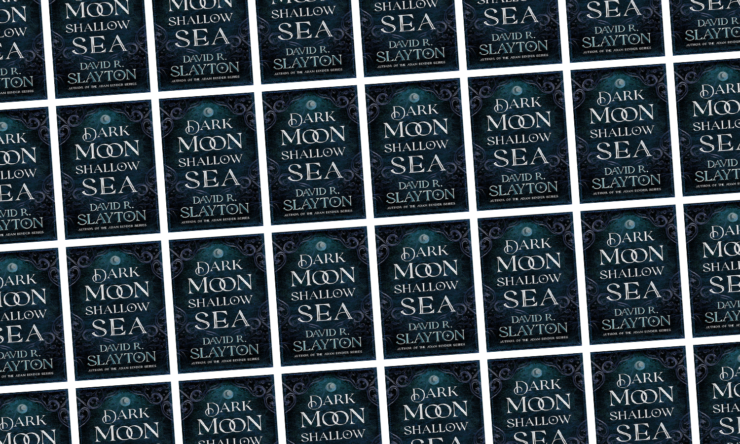Dark Moon, Shallow Sea by David R. Slayton opens with a world in crisis. Phoebe, goddess of the moon, has been killed and her followers outcast as heretics by the knights of the sun god Hyperion, for the alleged crime of consorting with demons. The tides have stopped, the sky is dark, and the souls of the dead are no longer taken to the underworld as they should be, but instead linger on as bloodthirsty ghosts. And things are only getting worse.
Enter Raef. A former acolyte of Phoebe, raised in her temple, he lives on the street and works as a thief. When a contact informs him about a gilded box being kept at the temple of Hyperion, he decides that he’s willing to take the risk—both for the money and for the chance to get back at Hyperion. But what he finds in the box isn’t gold, or jewels, or some saint’s bones or holy relic, but a young man named Kinos. As he smuggles Kinos out of the temple, Raef already begins to notice how attractive Kinos is, how warm his smile is.
Kinos tells him he’s from an island named Eastlight, far out across the sea. With the knights of Hyperion pursuing them, desperate for their prize back—and with Raef and Kinos growing closer to one another—Raef decides that he has to get Kinos back home.
Pursuing them are a cadre of Hyperion’s followers, including his unnamed Bishop and the young, golden-haired knight Seth, who serves as our point-of-view character on the side of the sun. But unlike the seeming zealots that surround him, Seth isn’t entirely sure of his faith, and when he summons the magical flames of Hyperion, they burn and blister his own skin as well. His mission is, of course, to drag Raef back to Hyperion’s temple for his crimes—but when they encounter one another at a masquerade ball, Seth helmed and Raef masked, Seth finds him attractive and asks him to dance.
Buy the Book


Dark Moon, Shallow Sea
The back cover of the book and the ghost-stricken world in which it’s set promise a gritty, divine fantasy in the vein of Dark Souls games or Brandon Sanderson’s Mistborn series. The driving question that story presents is, how will this dying world be saved? How will Phoebe be resurrected and the moon brought back into the sky? But the character dynamics, the awkward romantic fumblings of both Raef and Seth, are set up for a different story—a light fantasy romance. How will we get this TikTok-perfect romance, that story asks; how will the fiery knight sun-themed boy and the shadowy thief moon-themed boy fall in love?
Neither of those are bad stories. We need both dark, expansive fantasies and soft, queer fantasies. But it’s a question of expectations—both those of mine going in, and those the book sets for itself as it tries to blend these two very different stories and tones. And ultimately, Dark Moon, Shallow Sea doesn’t quite manage it, feeling sometimes like it was trying to tell both at once.
Raef and Seth have the weight of the world on their shoulders, quite literally. The balance of the gods is in crisis, and, in the temples of Hyperion and Phoebe, they find information which reshapes their knowledge of their own history, and the world’s. But Dark Moon doesn’t push them to act like it because of the concurrent romance story happening, where Raef and Seth are awkward young men working their way, at least in Seth’s case, towards their first kiss.
It’s a tonal mismatch that the book never figures out how to resolve—and once I recognized it, some of the plot-heavy or perilous moments (those most aligned with the grittier aspects of the story) lost their weight. Raef and Seth ended up in mortal danger more than once, and yet I found that I was never quite convinced of that danger. A romance wouldn’t just kill off its leads—that would defy the expectations of that genre, and simply wouldn’t be satisfying.
It’s a shame to lose that weight, because the world of Dark Moon is a fascinating place. The gods of the world—Hyperion, Rhea, and (until recently) Phoebe are not the creators of the world, their myth holds. Instead, they arrived at a world populated by demons and fought them off to claim it. I loved, when reading it, the physicality of Phoebe’s death. Many other fantasy books tie a god’s existence to their believers, their power tied in some nebulous way to the support they get from temples and worshippers. The most famous example might be Terry Pratchett’s Small Gods, where a god is reduced to a powerless turtle because he has no true believers left.
In contrast, even the title of Dark Moon demonstrates the immediate, palpable consequences of killing Phoebe: There’s no moon. Raef notes briefly that even if killing Hyperion in response was feasible, no one would dare do it, because stripping the sun from the sky would be much worse.
Dark Moon, Shallow Sea is just the first in a new fantasy series—and I’m certainly excited to see what the next books bring!
Dark Moon, Shallow Sea is available from Blackstone Publishing.
Read an excerpt.
Charles Bonkowsky is the president of Columbia University’s Science Fiction Society and loves talking to people about books.










